Search
▼ FOOD REPLICAS - Treats You Can't Eat
- Category:Other
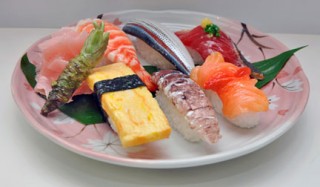
WEB JAPAN
Curries, hamburgers, sushi. Restaurants in Japan often display tasty-looking food in their windows. But this sort of food is not for eating, no matter how good it looks. These food models are replicas, and restaurants display them so potential customers can see at a glance what is on the menu. The replicas, peculiar to Japan, are surprisingly realistic, produced by expert craftsmen with sophisticated techniques.
Exquisite Japanese craftsmanship
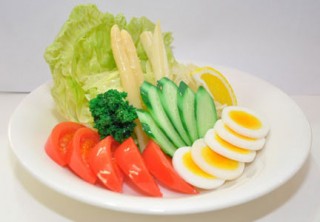
Salad replica with juicy-looking vegetables (Maiduru Asakusa Kappabashi Store)
Food replicas were first created in Japan some 90 years ago at a department store restaurant in Tokyo. The practice has since spread across the country. Restaurants had previously displayed real food, but the dishes on display would change shape and color as the day progressed. Department stores with high customer volumes throughout the day needed to find a way to display food that would not degrade over time. They started using food replicas as a new way to bring in business.
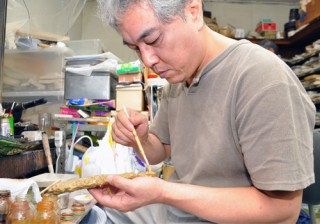
Craftsman coloring a replica meat dish with a fine brush (Koshigaya Factory, Sato Food Samples)
The replicas are made to look exactly the same as real food. They are designed to be the same size, shape and color as an actual dish. They also have a realistic feel and shine, and some even come with grill marks.
Food replicas were originally made out of wax, but today they are made of more durable synthetic resins. A silicon mold is made of the food and this is filled with colored liquid plastic. The mold is baked at around 150°C to set the resin and produce the cast.
The next step involves coloring the shape. This requires careful craftsmanship to produce exactly the right shades of color for the food. The craftsman examines every detail of the actual food and applies oil-based paints to the set plastic using fine brushes. A coat of glaze is then added for dirt resistance and the replica is finished.
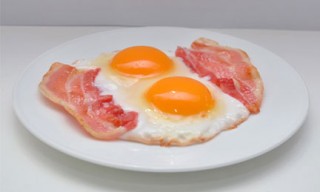
Perfect replica of bacon and eggs that even shows the shine on the bacon and the half-cooked egg yolk (Maiduru Asakusa Kappabashi Store)
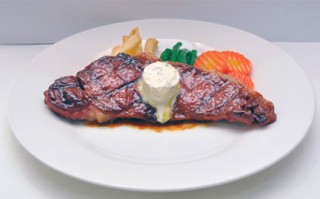
Replica steak with realistic char-grill marks (Maiduru Asakusa Kappabashi Store)
Making one's own food replicas
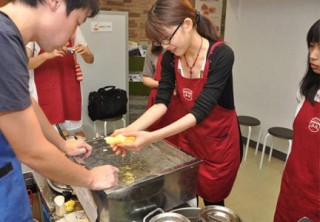
Learning how to make a prawn tempura replica (Kappabashi Showroom, Ganso Sample-ya, IWASAKI Co.)
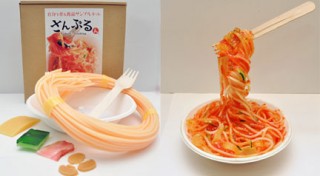
Replica spaghetti dish made from a kit that allows you to assemble a food replica at home. The floating fork wound around with spaghetti is one of the most popular kit items.
Kappabashi, or Kitchen Town as it is popularly known in English, is an area in Tokyo with many food-themed stores just a stone's throw from the popular Asakusa sightseeing spot. The stores sell everything from tableware and cookware to food replicas. The showrooms of food replica companies run almost daily sessions on how to make food models. These workshops have proved very popular, particularly among women and children.
At the sessions, attendees get to try their hand at making food replicas from the traditional material of wax. The challenge is to make typical Japanese food like tempura or vegetables such as lettuce, with guidance on the basics from a teacher.
To make real tempura, prawns, vegetables and other foodstuffs are dipped in a batter of flour with egg and then fried. To make a prawn tempura replica, liquid wax is dripped in strings from a paper cup at a height of about 60 cm into water heated to about 40°C. The key point here is to drip the wax from that exact height to make the tempura batter. The wax spreads out unevenly on the water surface, turning into a bumpy sheet. Once formed into the right shape, you have a tempura replica that looks like it would be crisp and crunchy to eat.
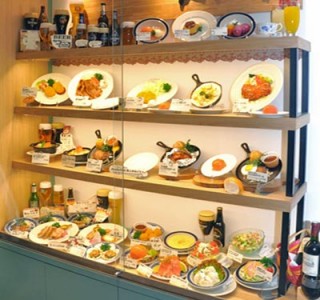
It is difficult to make food replicas as intricate as those made by professionals, but attendees at the food replica sessions have lots of fun trying to make their replicas look like those on display at restaurants.
Food replica kits to make at home for fun are also on sale. These contain all the materials needed to make replicas of food such as pizza, parfait or spaghetti wound around a fork, which looks like floating in the air.
Food replicas as accessories
Derived from original food replicas, miniature food replicas on key rings, mobile-phone straps or bookmarks are now popular. You can get cute replicas of almost any food, from sushi, fried rice or steak to cake, fruits and cookies. Even though they are miniature replicas, the food is still reproduced in fine detail, down to the fat on a ham bookmark or oozing cream on a cookie mobile-phone strap. They all look delicious! Students love weird stationery, such as pizza slice triangle rulers. These small replicas are inexpensive and have become popular as souvenirs among Japanese and foreign tourists visiting the food replica shops in Kappabashi.
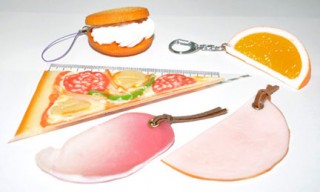
Amusing food replica accessories, including ham bookmarks and a pizza triangle ruler.
Food replicas were invented by the Japanese, known for being particular about making things, and have become an integral part of Japan's food culture. Part of the fun of dining out in Japan is deciding on what you are going to eat based on the food replicas on display in the window. It all looks good — what are you going to have?
- October 7, 2015
- Comment (0)
- Trackback(0)

